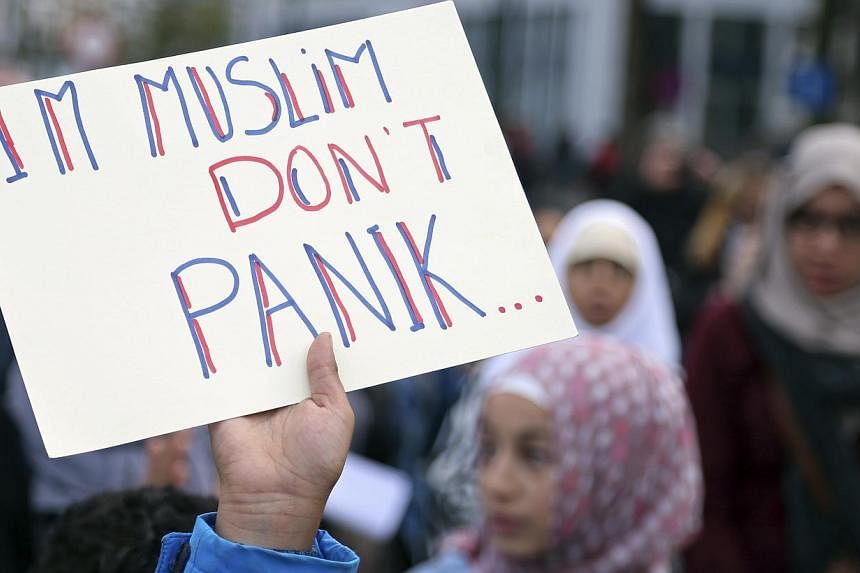What percentage of the total population is Muslim? This was a question in a recent UK poll. The average number calculated from respondents' replies was 21 per cent. The actual figure is 5 per cent.
In the United States, people think Muslims make up 15 per cent of its total population when it is only 1 per cent. In France, people think 31 per cent of its population are Muslims when the figure is actually 8 per cent.
So what makes people overestimate the number of Muslims in their midst so wildly?
While respondents were also off the mark when it came to guessing the number of immigrants as a percentage of the population, the difference between reality and their estimates was not as wide. It would appear that the bigger the figure for Muslims in a person's mind, the greater his discomfort at their presence.
Over the years, a number of factors have fed into an anti-Muslim prejudice and perceptions.
Firstly, Muslims in the West form a very visible community as a majority of the women wear traditional clothing, with many opting for either the full niqab or a headscarf; young men often grow beards. They thus stand out in a way other communities don't.
The community also preserves its cultural and religious practices by not going to pubs and insisting on halal meat. Then there are many horror stories in the media about forced marriages and honour killings that take place in Muslim communities.
After the fatwa against Salman Rushdie and worldwide riots over the Danish newspaper cartoons, Muslims are also seen as violent and humourless people who cannot abide criticism of their faith, even in fiction. Reports about non-Muslims persecuted and even killed under the blasphemy laws reinforce this perception of an intolerant community.
People in the UK were appalled when Mohammed Asghar, a 70-year-old British citizen with a history of mental illness, was condemned to death in Pakistan for alleged blasphemy. In a newspaper interview, his daughter expressed her rage over the fact that he had been shot while in jail.
Even more damaging to the image of Muslims in Britain have been the widely covered reports about gangs of mostly Pakistanis who have been preying on vulnerable young girls for years.
While the dictates of political correctness have prevented many from openly viewing this in purely Muslim/Pakistani terms, there is little doubt that these horrifying events in towns like Rotherham and Rochdale have only reinforced existing prejudices.
Ms Perveen Qureshi, director of the United Multicultural Centre in Rotherham, talked to the media about how Muslim community elders hushed up the scandal instead of going to the police.
Britain was shocked and enraged to find out that over a 16-year period, around 1,400 young girls had been brutally exploited by a gang of Muslim men.
Police, parents and social workers interviewed in the wake of this report were of the view that this was a nationwide problem, and it is only now that the police are arresting and prosecuting those involved. Earlier, the police failed to take allegations seriously as they thought that in many cases, the girls were "asking for it" by their clothing and behaviour. Often, the victims were under care, and their supposed carers ignored their plight.
Although many non-Muslims have committed similar crimes, in the public's perception, it is Muslims - and specially Pakistanis - who prey on vulnerable young white girls.
And of course, the fear of home-grown terrorism is ever present. Hardly a month passes without some plot being uncovered. Currently, the concern is about young Muslim radicals going off to Syria to fight with extremist groups like Al-Nusra and the Islamic State in Iraq and Syria (ISIS), and then returning to launch attacks in the UK.
Events in the Middle East also contribute to this Islamophobia: When two British aid workers were beheaded by ISIS, the vi-deos of their vicious decapitation sent a wave of anger and revulsion across Britain.
Although many Muslim clerics in the United Kingdom have condemned the acts, the fact that hundreds of young British Muslims have opted to be on the same side as these jihadists has turned a large section of the public against the community.
All these fears and prejudices have combined to form a very negative image of Muslims in Britain. But things are much worse in France and Holland where legislation targeting Muslim attire has been passed. It would seem that as attitudes harden, this will be the trend for the future.
Steadily, openly anti-Muslim voices have gained respectability and support. Bat Ye'or's "Eurabia" concept has gained traction on the right, with figures like the Dutch politician Geert Wilders attracting a growing audience for his anti-Islam diatribes. In Britain, a liberal, tolerant majority has prevented extreme Islamophobia from going mainstream as it has done in France.
The focus in the UK is immigration from EU member countries. This has given rise to the UK Independence Party, which is now threatening the dominance of the three major parties.
But question marks about the Muslim community remain.
DAWN/ASIA NEWS NETWORK

